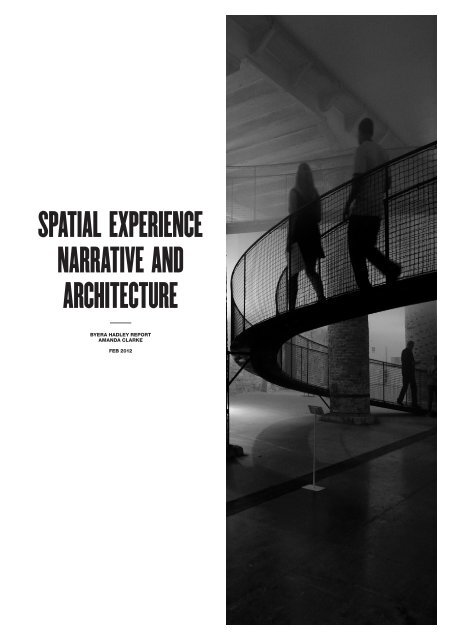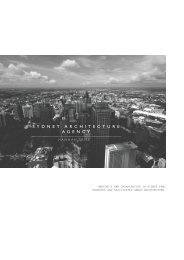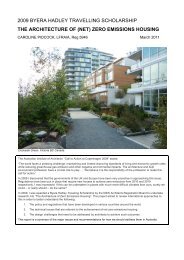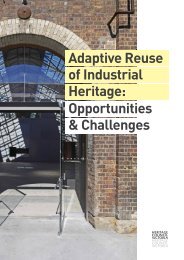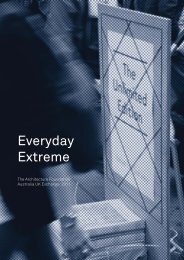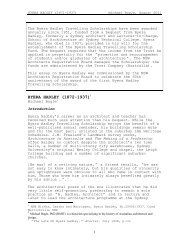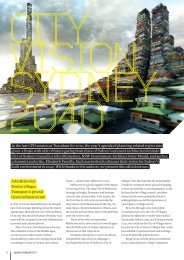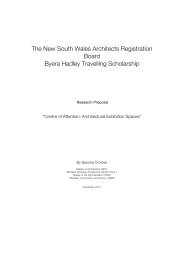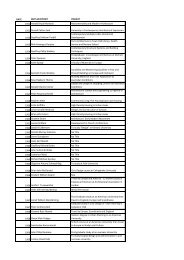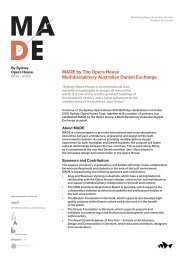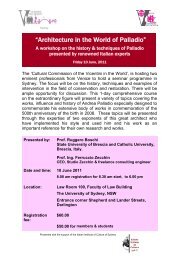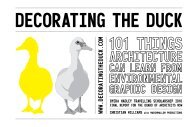spatial experience narrative and architecture - Architecture Insights
spatial experience narrative and architecture - Architecture Insights
spatial experience narrative and architecture - Architecture Insights
Create successful ePaper yourself
Turn your PDF publications into a flip-book with our unique Google optimized e-Paper software.
CONTENTS1.0 INTRODUCTION 062.0 CASE STUDY 012.1 12th International <strong>Architecture</strong> ExhibitionVenice Biennale 2010 072.2 ‘Cloudscapes’ exhibit,Transolar <strong>and</strong> Tetsuo Kondo Architects 082.3 ‘Metropolis’ exhibit: French pavilion 102.4 ‘Vacant NL’ exhibit: Netherl<strong>and</strong>s pavilion 123.0 CASE STUDY 02Practitioners of the In-between 143.1 Film + <strong>Architecture</strong>: Spatial Intelligence 143.2 Temporality, Memory & sequence 163.3 Narrative: Re-imagining <strong>Architecture</strong> <strong>and</strong>the role of the Architect 194.0 CASE STUDY 03Temporary <strong>Architecture</strong> 204.1 Architectural Redevelopment Project:‘First Church of Christ the Scientist’ Sydney 205.0 REFLECTIONS/CONCLUSIONS 256.0 ENDNOTES 277.0 APPENDIX 287.1 Short Biographies: Interview subjects8.0 BIBLIOGRAPHY 31
SPATIAL EXPERIENCE, NARRATIVE & ARCHITECTURE - BYERA HADLEY REPORT 61.0 INTRODUCTION1.0INTRODUCTION1.1 INTRODUCTION‘Spatial <strong>experience</strong>, Narrative <strong>and</strong> <strong>Architecture</strong>’explores the relationship between the two disciplinesof film <strong>and</strong> <strong>architecture</strong>, the various ways theyintersect, <strong>and</strong> the various practitioners who work inthis discipline of the in-between.The aim of the research is two-fold.1. The research aims to prompt an intensiveengagement with the temporary, sensorial <strong>and</strong>social qualities of space <strong>and</strong> a fresh considerationof <strong>architecture</strong>. The relevance of studying therelationship between film <strong>and</strong> <strong>architecture</strong> ispursued as a specific source of inspiration <strong>and</strong>tool in the process of architectural design work.In addition, the investigation aims to explore howthe link between architectural space <strong>and</strong> filmspace might inform the exp<strong>and</strong>ed conception <strong>and</strong>practice of <strong>architecture</strong>.2. A consideration of film as an art form relying ontemporary architectural environments will aid inthinking through the <strong>experience</strong> of <strong>narrative</strong> in thecity. Those who engage with temporary eventsin the city, such as festivals <strong>and</strong> exhibitions,underst<strong>and</strong> how <strong>spatial</strong> <strong>experience</strong> can comeinto being <strong>and</strong> change through these temporaryevents. The project will research ways in whichthe <strong>architecture</strong> profession can engage with whatcreates this kind of <strong>experience</strong> of the city.In a related way, the <strong>experience</strong> <strong>and</strong> observation ofa major architectural exhibition (12th International<strong>Architecture</strong> Exhibition, Venice 2010) will aid inunderst<strong>and</strong>ing the architectural possibilities of the<strong>spatial</strong> sequence of temporary structures. Theinvestigation will pursue how these qualities mighttranslate to more enduring <strong>spatial</strong> conditions in<strong>architecture</strong>. This knowledge will also be used torethink the way in which <strong>architecture</strong> deals with<strong>spatial</strong> sequence <strong>and</strong> <strong>spatial</strong> <strong>narrative</strong> in cities.I have chosen three distinct <strong>and</strong> specific casestudies to frame this research.Case study 01: Analysis of the 12th International<strong>Architecture</strong> Exhibition, Venice 2010.Case study 02: Interview series with a selection ofarchitectural/academic professionalswho straddle the professional worldsof film, <strong>architecture</strong> + art (based InLondon <strong>and</strong> Berlin).Case study 03: Analysis of architecturalre-development project‘First Church of Christ the Scientist’(Heritage building), east Sydney.My ambition is that this varied range of casestudies from the intersecting worlds of film, art<strong>and</strong> <strong>architecture</strong> may reveal an exp<strong>and</strong>ed field ofdesign opportunities for architectural practitioners inAustralia.PICTUREDTransolar & Tetsuo Kondo Architects,‘Cloudscapes’, Arsenale VeniceBiennale 2010
SPATIAL EXPERIENCE, NARRATIVE & ARCHITECTURE - BYERA HADLEY REPORT 72.0 CASE STUDIES2.012TH INT. ARCHITECTURE EXHIBITION2.1 12th International <strong>Architecture</strong> ExhibitionThe <strong>experience</strong> <strong>and</strong> observation of a majorarchitectural exhibition (12th International <strong>Architecture</strong>Exhibition, Venice Biennale 2010) was used toaid in underst<strong>and</strong>ing the architectural possibilitiesof the <strong>spatial</strong> sequence of temporary structures.The Director of the 12th International <strong>Architecture</strong>exhibition “People meet in <strong>Architecture</strong>”, KazuyoSejima of SANAA stated, “The 2010 edition of theBiennale is an exhibition about finding <strong>architecture</strong>;to reconsider the potential of <strong>architecture</strong> incontemporary society”. 1 The exhibition, ‘People meetin <strong>Architecture</strong>’ showcased 48 participants: firms,architects, engineers <strong>and</strong> artists from around theworld <strong>and</strong> ran from 29th August-21st November 2010at the Giardini <strong>and</strong> the Arsenale <strong>and</strong> in various othervenues in Venice. 2The Arsenale site:The South-East area of the historic Arsenale sitehas become the stable site of the Biennale activitiessince 1999, with exhibition spaces such as: Corderie,Artiglierie, Gaggi<strong>and</strong>re, Tese Cinquecentesche, <strong>and</strong>Tese delle Vergini. 3 Kazuyo Sejima invited theparticipants of this group exhibition to explorethe relationship between <strong>architecture</strong> <strong>and</strong> humaninteraction. Many architects were also invited to studytheir own work in films in an attempt to explore howpeople within the space make the space itself. 4 Theresulting collection of temporary installations at theArsenale was extremely diverse.”Individuals will be showing their position towards theinteraction of new social <strong>and</strong> natural environments; allof which means that each person is his or her owncurator. This way the atmosphere of the exhibitionitself will be achieved through multiple points of viewrather than a single orientation” (Sejima). 5 While thecollection of installations infused the historic site withnew life, they read as separate parts. The <strong>spatial</strong>sequence of the exhibition as a whole seemed quitearbitrary over the five exhibition spaces on the South-East end of the Arsenale. The most engaging of theworks was ‘Cloudscapes’ by Transolar <strong>and</strong> TetsuoKondo Architects. This installation successfullyacknowledged the space <strong>and</strong> materiality of thebuilding it inhabited, <strong>and</strong> encouraged increaseddegrees of interactivity (refer Section 2.2).The Giardini site:The Giardini site housed the various Nationalexhibitions. Sejima stated, “This exhibition allowspeople to acknowledge various ideas from diversebackgrounds <strong>and</strong> will reflect the present, which initself encapsulates future potential. (Her) hope wasthat the show would be an <strong>experience</strong> of architecturalpossibilities; about an <strong>architecture</strong> created bydifferent approaches, expressing new ways of living.” 6The French <strong>and</strong> the Netherl<strong>and</strong>s pavilions used theirexhibition to rethink the way in which <strong>architecture</strong>deals with <strong>spatial</strong> sequence <strong>and</strong> <strong>spatial</strong> <strong>narrative</strong>in cities. Both these exhibitions framed this ideathrough the focus on empty <strong>and</strong> available spaces inthe urban environment <strong>and</strong> how these spaces mightbe productively re-integrated for urban renewal (referSection 2.3-2.4).PICTUREDLocation photograph Arsenalesite
SPATIAL EXPERIENCE, NARRATIVE & ARCHITECTURE - BYERA HADLEY REPORT 82.0 CASE STUDIES2.2 CLOUDSCAPESTransolar <strong>and</strong> Tetsuo Kondo ArchitectsA significant installation that took place in theArsenale Artiglierie was “Cloudscapes” by Germanengineering firm Transolar <strong>and</strong> Tetsuo KondoArchitects. They collaborated to create a real cloud,with clear extents, in the Arsenale Corderie, the effectbeing an ethereal layering of the Arsenale space.This installation housed a series of ramps that invitedvisitors to <strong>experience</strong> an ephemeral atmosphere frombelow, within <strong>and</strong> above using a ramp that windsthrough the space, with varying levels of visibility<strong>and</strong> humidity. 7 The cloud greatly affected the naturallight qualities in the space, imbuing the space witha theatrical atmosphere. The temporary insertion oframps into the space allowed the participant to gainaccess to new vantage points of the original building,previously inaccessible.Mise-en-scène is an expression used to describe thedesign aspects of a theatre or film production, whichessentially means “visual theme” or “telling a story”-both in visually artful ways through storyboarding,cinematography <strong>and</strong> stage design, <strong>and</strong> in poeticallyartful ways through direction. 8 When applied to thecinema, mise-en-scène refers to everything thatappears before the camera <strong>and</strong> its arrangementcomposition,sets, props, actors, costumes, <strong>and</strong>lighting. 9 Transolar <strong>and</strong> Tetsuo Kondo Architectsadopted a very filmic approach to architectural spacein this work, which had to do with people in space,<strong>and</strong> experiencing that space. They were interestedin how “you will change the space <strong>and</strong> how it willchange you.” 101The images show different views of the exhibitionspace. Images 2-4 follow the movement sequence Itook through the space via the spiral ramp. The rampallowed for a detailed exploration of Architecturalfeatures such as the existing columns <strong>and</strong> ceilingspace. From the crest of the ramp the mist wouldcover the entire floor level with changing degrees ofvisibility. This added new vistas, <strong>and</strong> removed others,making the space feel alternatively more, or lessintimate. The ‘cloud’ also altered <strong>and</strong> enhanced thelight effects in the room, as can be seen in image 6.The use of props <strong>and</strong> atmospheric effects incombination with the existing building encouragedthe viewer to <strong>experience</strong> the space in new waysbased on a new set of sensory stimuli.2PICTUREDTransolar & Tetsuo Kondo Architects,‘Cloudscapes’, Arsenale Venice<strong>Architecture</strong> Biennale 20103
SPATIAL EXPERIENCE, NARRATIVE & ARCHITECTURE - BYERA HADLEY REPORT 92.0 CASE STUDIES45PICTUREDTransolar & Tetsuo Kondo Architects,‘Cloudscapes’, Arsenale Venice<strong>Architecture</strong> Biennale 20106
SPATIAL EXPERIENCE, NARRATIVE & ARCHITECTURE - BYERA HADLEY REPORT 102.0 CASE STUDIES2.3 French Pavilion:'Metropolis' exhibit, Giardini Venice<strong>Architecture</strong> Biennale 2010French Architect Dominique Perault was the curatorof the French Pavilion. His project explored the themeof ‘Metropolis.’ The theme aimed to demonstrate thata metropolis itself is not a city but rather a territorymostly comprised of empty <strong>and</strong> available spaces.Consequently, the perception of these voids as theplaces where all possibilities can still be realizedguided the approach to the subject <strong>and</strong> overalldesign of the pavilion.To illustrate his ideas, Dominique Perrault invitedfive major actors on the French scene: themetropolises of Bordeaux (Housing, Tidal Docks,Transportation…), Lyon (Lyon Confluences <strong>and</strong>district of La Part Dieu…), Marseille (Metropolis inmotion, Parallel routes, Coastal scenery…), <strong>and</strong>Nantes (Territory, Nantes Saint-Nazaire Estuary, Ilede-Nantes,EuroNantes, the Ile-de-Nantes, planningdu Gr<strong>and</strong> Paris. Five experiments, five ways of linkingsolids <strong>and</strong> voids, five proposals for a definition ofthe metropolis no longer conceived of as a physicalmass but rather as a territory.1These Five examples, treated through films<strong>and</strong> projected texts were designed in a highlycinematographic way. Walls of the exhibitionspace were covered from floor to ceiling with filmprojections. The interplay of screens <strong>and</strong> mirrorsexponentially increased images <strong>and</strong> sensations,enhanced by background sounds comprised ofmetropolitan noises. The result was an immersivesensory environment, enabling the viewer to graspthe full scope of the metropolis as an idea, <strong>and</strong> alsoengage with the discourse on an imaginative level:through mental images, sensations <strong>and</strong> concepts. 11I was interested in the method Perrault used topresent information, <strong>and</strong> its effectiveness as acommunication tool. By creating an immersivesensory environment, the viewer was placed in asubjective position to the ideas expressed. TheFrench pavilion presented various levels of visual<strong>and</strong> audio information simultaneously; in the formof photos <strong>and</strong> film footage of the urban l<strong>and</strong>scape,statistical data, mapping, diagrams, soundscapes<strong>and</strong> discourse. This environment made the concepteasy to absorb experientially <strong>and</strong> define one’s own<strong>experience</strong> of the ‘metropolis’. The images showthe various techniques used: Image 1 <strong>and</strong> 3 showthe use of mirrors to reflect similar threads of visualinformation to the viewer from different perspectives.PICTURED‘Metropolis’exhibit, French pavilionGiardini Venice, <strong>Architecture</strong> Biennale20102
SPATIAL EXPERIENCE, NARRATIVE & ARCHITECTURE - BYERA HADLEY REPORT 112.0 CASE STUDIES3PICTURED‘Metropolis’exhibit, French pavilionGiardini Venice, <strong>Architecture</strong> Biennale20104
SPATIAL EXPERIENCE, NARRATIVE & ARCHITECTURE - BYERA HADLEY REPORT 122.0 CASE STUDIES2.4 Netherl<strong>and</strong>s Pavilion‘Vacant NL - Where <strong>Architecture</strong> meetsideas’ exhibit, Giardini Venice,<strong>Architecture</strong> Biennale 2010The Netherl<strong>and</strong>s Pavilion, ‘Vacant NL - Where<strong>Architecture</strong> meets ideas’ exhibit, made subject ofthe thous<strong>and</strong>s of buildings in the Netherl<strong>and</strong>s thatremain unoccupied. Vacant NL aimed to show howthis enormous quantity <strong>and</strong> diversity of temporarilyavailable property offers a range of possibilities, <strong>and</strong>that temporary use can give positive impulse forinnovation within the creative knowledge economy.Ironically, the building where the exhibition tookplace had also been empty for over 39 years sinceits inauguration in 1954. Rietveld L<strong>and</strong>scape (theexhibition curators) emphasized the theme by leavingthe ground level of the pavilion empty. From below,one could make out a suspended ceiling of bluefoam. From the first level of the pavilion, thesuspended field revealed itself to be a collection ofmodel churches, schools, water towers, factories,hangars, light houses <strong>and</strong> offices. A diagram on thewall showed the connections that could be madebetween vacant buildings <strong>and</strong> creative professionals.The curators explored an existing scenario withintheir urban environment to strategically re-imaginenew <strong>spatial</strong> possibilities at an urban scale. 12This installation tackled similar ideas in part to theFrench pavilion regarding the productivere-use of empty <strong>and</strong> available spaces in the urbanenvironment. It used a very different format however.The exhibit played games with the presentation ofurban scale in order to make the concept accessibleto the viewer. From underneath the models appearedas a field, resembling a figure-ground study. FromPICTURED‘Vacant NL’ exhibitNetherl<strong>and</strong>s pavilion, Giardini Venice<strong>Architecture</strong> Biennale 2010
SPATIAL EXPERIENCE, NARRATIVE & ARCHITECTURE - BYERA HADLEY REPORT 132.0 CASE STUDIESabove, this collection of model buildings could beseen to have distinct character <strong>and</strong> identity. The useof scale models, clustered together to express thegreat mass of empty <strong>and</strong> available buildings in theNetherl<strong>and</strong>s, showed the vastness of a conditionnot perceptible as separate parts. The argumentwas strengthened by acknowledging the historicalcondition of the existing building (having been emptyitself for over 39 years).PICTURED‘Vacant NL’ exhibitNetherl<strong>and</strong>s pavilion, Giardini Venice<strong>Architecture</strong> Biennale 2010
SPATIAL EXPERIENCE, NARRATIVE & ARCHITECTURE - BYERA HADLEY REPORT 143.0 PRACTITIONERS OF THE IN-BETWEEN3.0PRACTITIONERS OF THE IN-BETWEEN3.1 Film + <strong>Architecture</strong>: Spatial IntelligenceA series of interviews were conducted withArchitectural/Academic professionals from London<strong>and</strong> Berlin, who straddle the professional worldsof <strong>architecture</strong>, film <strong>and</strong> art. The conversationshighlighted particular concepts such as <strong>spatial</strong>intelligence, memory, temporality <strong>and</strong> <strong>narrative</strong>.These concepts have been used in the followingchapter to frame the link between film + <strong>architecture</strong>.Christophe Gérard is the founding director of‘Criticalspace’, an academic specialist on the subjectof film+<strong>architecture</strong> (having co-ordinated <strong>and</strong> taughtprograms at The Bartlett UCL, UK), an Architect, afilmmaker <strong>and</strong> highly <strong>experience</strong>d scenographer. 13Chistophe Gerard described ‘Film + <strong>Architecture</strong>’ “asa discipline between two disciplines <strong>and</strong> a disciplineof the in-between. It deals with the pollution, thecontamination of each discipline, film <strong>and</strong><strong>architecture</strong>, by the other. It looks at the wayarchitectural-space <strong>and</strong> film-space collide, inform <strong>and</strong>reconfigure one another.” 14Baudrillard reminds us that <strong>architecture</strong> is notwhat fills the space but what generates it. 15 Whenconsidering the link between architectural space<strong>and</strong> film space, one must consider that space isultimately generated in our mind: it is a combinationof our perception, our <strong>experience</strong> of space, altered orpondered by such things as our personal knowledge,memory <strong>and</strong> our state of mind. Gerard suggests,the real space, like the filmic space you reconfigure inyour mind from irreconcilable snippets, <strong>and</strong> differentpoints of view, is ultimately a mental space. Hesuggests that is where film <strong>and</strong> <strong>architecture</strong> meet up,where film in generating space, in a sense, becomes<strong>architecture</strong>, <strong>and</strong> again why as architects we have tolook into films.“Film provides a very rich representation of<strong>architecture</strong>” (Gerard). 16 Gerard stated in our interviewSeptember 2010, that “film as a medium developsthe conception (both the mental picture <strong>and</strong> the actof conceiving) of <strong>architecture</strong>.” He elaborated on thistopic by describing how the filmic space confrontsus with specific aspects of physical space that asarchitects we are contributing to (<strong>and</strong> physical spacehas to be taken here in its broadest meaning: thesensorial space, the social space… etc). In film,space is <strong>experience</strong>d through sounds, motions<strong>and</strong> e-motions, <strong>and</strong> we comprehend its invisibleboundaries. Film is therefore a good material ofstudy to exp<strong>and</strong> our underst<strong>and</strong>ing of <strong>architecture</strong><strong>and</strong> change the way we go about making it.PICTURED‘The Rise’Exhibition view,Stedelijk Museum BureauAmsterdam, 2007Image source:http://fischerelsani.net/
SPATIAL EXPERIENCE, NARRATIVE & ARCHITECTURE - BYERA HADLEY REPORT 153.0 PRACTITIONERS OF THE IN-BETWEENBerlin based artists Nina Fischer <strong>and</strong> Maroanel Sani focus on transitory spaces <strong>and</strong> vacuumsituations in urban environments, collective memory<strong>and</strong> vision in various media such as film, video,installation <strong>and</strong> photography. 17 They use their workto discuss the relationship between buildings <strong>and</strong>their psychological effect. The films by these twoartists are frequently concerned with visualisingurban architectural settings in order to address theparameters of a discourse on space that has shapedthe 20th century. In the installation work ‘The Rise’they explore “the complex relationship betweenthe visual language of a building, its psychologicaleffects <strong>and</strong> the political-economic reality in which itfunctions.” 18This work examines the architectural reality of aneighbourhood in Amsterdam undergoing radicalchange. In conversation with the artists, they referredto the work of Anthony Vidler ‘The ArchitecturalUncanny: Essays in the Modern Unhomely’. Byrepeatedly using cinema to approach architecturalspaces of particular significance, they constantlyraise questions about the production of meaning inthat place. 19 There are many films also that are basedon this effect, like Hitchcock’s Vertigo, <strong>and</strong> alsorecent films that play in the modern environment ofempty office cities by night. The house, which usuallyshould be shelter, often becomes a frightening place,like a prison.PICTURED‘The Rise’Film stillsHD / 35 mm, 16:9,17 min.,loop,colour,Dolby Digital, 2007Image source:http://fischerelsani.net/
SPATIAL EXPERIENCE, NARRATIVE & ARCHITECTURE - BYERA HADLEY REPORT 163.0 PRACTITIONERS OF THE IN-BETWEEN3.2 Temporality / Memory & sequence<strong>Architecture</strong> still defines itself though permanence.The major link between film <strong>and</strong> <strong>architecture</strong> is time.They are time sensitive mediums.Film as a medium has the ability to capture the lifecycles of <strong>architecture</strong> <strong>and</strong> place. It can be usedstrategically to discuss these, <strong>and</strong> the memories heldwithin a certain building. As with many of Fischer & ElSani’s art projects (such as the aforementioned ‘TheRise’, their film project ‘Spelling Dystopia’ (2009) askshow memory operates, how a site wears its history,both physically <strong>and</strong> metaphorically. 20“History manifests itself in the diversity of <strong>architecture</strong>from different epochs. A building is a visible remnant<strong>and</strong> a piece of memory of a certain time. Our workis a permanent pursuit of <strong>and</strong> negotiation with thetransition of time, or the transition of epochs. Weexplore the historic traces of urban l<strong>and</strong>marks,monuments <strong>and</strong> events that embody such atransition” (Fischer & El Sani). 21Fischer & El Sani are interested in how cinema has animpact on locations, how it changes the perceptionof a place <strong>and</strong> causes a shift in collective memory.Christophe Gérard suggests that architects like totoy with concepts such as sequence <strong>and</strong> <strong>narrative</strong>,however there are other phenomena that might beconsidered (as evident in Fischer <strong>and</strong> El Sani’s work‘Spelling Dystopia’) like adaptation, appropriation <strong>and</strong>the blurring <strong>and</strong> time. 22 With ‘Spelling Dystopia’ theyfocused on the public perception of the uninhabitedisl<strong>and</strong> Hashima near Nagasaki, which has a vividhistory. In the year 2000 it became the film locationof a science fiction blockbuster Battle Royale <strong>and</strong>came back into the Japanese consciousness, witha different connotation. 23 The younger generationstarted to know the place mostly from movies,mangas <strong>and</strong> video games, as an ab<strong>and</strong>oned ghostisl<strong>and</strong>.Through these images the isl<strong>and</strong> appears almost asa fantasy, an imaginary playground where variousimages <strong>and</strong> layers of reality <strong>and</strong> fiction have alreadygot in a state of mingling. Aided by its appearancein Battle Royale the isl<strong>and</strong> has since taken on aghostly, mythic status in the national imagination, afictionalised shift in collective memory. 24PICTURED‘Spelling Dystopia’Exhibition view (top)Film still (bottom)Image source:http://fischerelsani.net/
SPATIAL EXPERIENCE, NARRATIVE & ARCHITECTURE - BYERA HADLEY REPORT 173.0 PRACTITIONERS OF THE IN-BETWEENPICTURED‘Spelling Dystopia’Film stillsImage source:http://fischerelsani.net/
SPATIAL EXPERIENCE, NARRATIVE & ARCHITECTURE - BYERA HADLEY REPORT 183.0 PRACTITIONERS OF THE IN-BETWEENMemory changes with the media that is produced atthese places. By producing a new artwork about aplace like Hashima Isl<strong>and</strong>, Fischer <strong>and</strong> El Sani aimedto bring memory back to the contemporary streamof media consumption, but also influence how it willbe remembered in the future. “By the format of afilm installation, that uses several screens we triedto create a new approach for the way to watch it”(Fischer & El Sani). 25PICTURED‘Spelling Dystopia’Film stillsExhibition view (bottom)Image source:http://fischerelsani.net/
SPATIAL EXPERIENCE, NARRATIVE & ARCHITECTURE - BYERA HADLEY REPORT 193.0 PRACTITIONERS OF THE IN-BETWEEN3.3 Narrative: Re-imagining <strong>Architecture</strong><strong>and</strong> the role of the ArchitectFilm + <strong>Architecture</strong> is an emerging discipline.Commissioners in each discipline are naturallynervous at the idea of someone working in betweentwo disciplines. Christophe Gérard expressed,that as a practitioner “one moves between thesedisciplines with difficulties. So my work tends tobe, at times, purely architectural, at others, purelyfilmic. Having said that, I have a filmic approach to<strong>architecture</strong> <strong>and</strong> an architectural approach to film -my knowledge in one domain enriches the other.” 26In the face of such limitations within the profession,how might practitioners critically revise the role ofthe architect, <strong>and</strong> operate in an exp<strong>and</strong>ed field ofarchitectural activities?Liam Young is an urbanist, architect <strong>and</strong> curatorwho currently lives <strong>and</strong> works in London. He isinterested in the way one uses a design project toput abstract ideas together <strong>and</strong> launch a project asa <strong>narrative</strong>. Liam is a founder of the futures think tank‘Tomorrows Thoughts Today’, a group whose workexplores the consequences of fantastic, perverse<strong>and</strong> underrated <strong>architecture</strong>s <strong>and</strong> urbanisms. Liam isalso a design lecturer coordinating at the AA, Bartlett,Chelsea College of Art <strong>and</strong> other schools throughoutEurope <strong>and</strong> Asia. His studios are positioned in theprojective worlds of speculation <strong>and</strong> fiction <strong>and</strong>become critical instruments for instigating debateabout the cultural consequences of emergingbiological <strong>and</strong> technological futures. 27Liam draws upon his Architectural education towork as a Designer, on architectural projects <strong>and</strong>‘architecturally informed’ projects with a rangeof applications. This takes form as Art, curation,<strong>architecture</strong>, teaching <strong>and</strong> event moderation. Hesuggests this exp<strong>and</strong>ed field of architectural activitiesis “one voice with many outputs.” 28 He seeks differentforums to address the same problems, to engage inproductive discussion <strong>and</strong> debate.Liam looks at different ways the Architect canoperate as a Designer & provocateur outside builtpractice. He stated, “the value of this speculativeprocess <strong>and</strong> projects is judged on how it filtersdown into the built world, <strong>and</strong> how it generates adiscussion. In addition, The Architect might usethis technique, these interventions, as a way tounderst<strong>and</strong> emerging technologies in this context<strong>and</strong> to review problems in a new way.” 29One such project Liam co-ordinated was ‘Winter2011_Strange times_far North Alaska: 0–180ºlongitude” as part of “the Unknown Fields Division.’ 30The Unknown Fields Division is a nomadic designstudio that travels on annual expeditions to theends of the earth exploring unreal <strong>and</strong> forgottenl<strong>and</strong>scapes, alien terrains <strong>and</strong> obsolete ecologies:“The otherworldly sites we encounter afford usa distanced viewpoint from which to survey theconsequences of emerging environmental <strong>and</strong>technological scenarios”(Unknown Fields Division). 31They annually navigate a different global crosssection <strong>and</strong> map the complex <strong>and</strong> contradictoryrealities of the present as a site of strange <strong>and</strong>extraordinary futures. The division mission states:“we are both visionaries <strong>and</strong> reporters, partdocumentarian <strong>and</strong> part science fiction soothsayersas the otherworldly sites we encounter afford usa distanced viewpoint from which to survey theconsequences of emerging environmental <strong>and</strong>technological scenarios.” 32Liam’s design methodology promotes the tools offiction <strong>and</strong> speculation to engage with urban <strong>and</strong>ecological problems in a real way in the present,as opposed to imagining a future. While thesespeculative projects are quite fantastical, this methodof designing ‘interventions’ <strong>and</strong> drawing comparisonsbetween ecological <strong>and</strong> urban environments hasthe ability to reveal particular problems <strong>and</strong> potentialsolutions via subtle fabrications <strong>and</strong> iterations.PICTUREDUnknown Fields DivsionProject imagesImage source:http://www.unknownfieldsdivision.com/
SPATIAL EXPERIENCE, NARRATIVE & ARCHITECTURE - BYERA HADLEY REPORT 204.0 TEMPORARY ARCHITECTURE4.0TEMPORARY ARCHITECTURE4.1 Architectural Re-development projectProject: The First Church of Christ theScientist Redevelopment ProjectType:Adaptive Reuse/ RefurbishmentLocation: Liverpool Street, East SydneyArchitect: Bates Smart SydneyDirector: Simon SwaneyProject Leader: Charmaine PangCompletion date: 2011<strong>Architecture</strong> has traditionally defined itself throughpermanence. An <strong>architecture</strong> that engages withtemporary residential <strong>and</strong> mixed use environmentswithin heritage buildings is indicative of a shift inthe way we think about <strong>Architecture</strong>, the role of theArchitect, <strong>and</strong> building life cycles in Australian cities.Christophe Gerard states: “We are living in a timewhere building life cycles are speeding up. The lifeexpectancy of a building is getting shorter, <strong>and</strong> it isnow more important than ever that architects have tothink about degradation <strong>and</strong> recycling”(Gerard). 33The First Church of Christ the Scientistredevelopment project suggests how the use oftemporary construction techniques (traditionally usedfor film set construction <strong>and</strong> exhibition construction)can translate to a more enduring <strong>spatial</strong> condition as<strong>architecture</strong>.This project first came to my attention throughcolleagues at the Sydney based <strong>Architecture</strong> practiceBates Smart. It became evident that this design/construction project from my professional world inArchitectural practice was employing parallel design/construction techniques to those I had witnessedfrom the contemporary worlds of Film <strong>and</strong> Art. It isa useful case study to explore some of the practicalapplications of the theories proposed by thisresearch.The Application for Development Approval, 2011states:“The architectural intent of the proposal is for theadaptive re-use of the former ‘First Church of Christthe Scientist’ to create a single dwelling withinthe auditorium by inserting a new structure whichexpresses its temporary quality, carries its owndistinctive identity, allows the existing space <strong>and</strong>fabric to be <strong>experience</strong>d <strong>and</strong> is able to be removedwithout impact <strong>and</strong> as such will be a fully reversibleadaptive reuse.It is intended that the new insertion will enable thearchitectural <strong>and</strong> <strong>spatial</strong> qualities of the auditorium tobe fully <strong>experience</strong>d by offering unimpeded views ofthe major volume whilst maintaining the natural lightqualities within the space.The challenge for the project is not only to berespectful <strong>and</strong> subservient to the gr<strong>and</strong>eur <strong>and</strong>eloquence of the original space but also to ensurethat all is done in a manner that is fully reversible. Thegoal is that when the main space is returned to a usethat is compatible with its original purpose, all originalbuilding fabric <strong>and</strong> furniture (i.e. pews) may be readilyre-used” (S. Swaney). 34ProgramThe first <strong>and</strong> current function of this development isa family residence. The future scenario imagined forthis building will include a mix of programs including,but not limited to, residential, commercial office,art/ gallery space, event /performance space,small scale retail <strong>and</strong> hospitality. 35 The hybrid natureof this project alludes to the current simultaneityof realities of movement <strong>and</strong> occupation, <strong>and</strong>categories of program. On an urban level, thescheme has the potential to provoke various patternsof public occupation in conjunction with structured<strong>and</strong> unstructured events occurring within the siteenvelope.The client of the project advised “the task ofinhabiting this building involves asking how the spacecan be used/ how one can <strong>experience</strong> it.” 36 Theproject proposes a layered set of event spaces <strong>and</strong>occupation within the existing envelope in order to“enliven” the building. The aspiration for this spaceis to create a community model, as schematic as itis flexible, capable of plotting events, altering itself<strong>and</strong> accommodating, at the same time, exteriorcontingencies.The residential design product was not a finitesolution, but a step in the process that could bere-informed, if needed, by greater complexity <strong>and</strong>detail. Architectural performance will be judgedover time <strong>and</strong> through an experimental process.The basic conception/ambition for this project isnot just functional, typological, or technical, butfocuses rather on creating new <strong>spatial</strong> <strong>experience</strong>s,pinpointing the way in which a critical revision ofresidential <strong>and</strong> mixed-use paradigms can intersectwith contemporary culture. 37 The challenge was, <strong>and</strong>continues to be to develop an architectural designthat has the ability to index multiple sets of urb<strong>and</strong>ata relevant for the local community, <strong>and</strong> mediatebetween different conditions.1 2 3PICTURED1+2. First Church of Christ the Scientist’exterior site photo, 2011 Photographer: Marcus Clinton,2+3. ‘First Church of Christ the Scientist’interior site photo, 2011
SPATIAL EXPERIENCE, NARRATIVE & ARCHITECTURE - BYERA HADLEY REPORT 214.0 TEMPORARY ARCHITECTUREPICTURED‘First Church of Christ the Scientist’redevelopment complete,Interior photos, Jan 2012Photographer: Marcus Clinton
SPATIAL EXPERIENCE, NARRATIVE & ARCHITECTURE - BYERA HADLEY REPORT 224.0 TEMPORARY ARCHITECTUREPICTURED‘First Church of Christ the Scientist’redevelopment in construction phase ,interior site photos, 2011 (various)Image source: Bates Smart Sydney
SPATIAL EXPERIENCE, NARRATIVE & ARCHITECTURE - BYERA HADLEY REPORT 234.0 TEMPORARY ARCHITECTUREPICTURED‘First Church of Christ the Scientist’redevelopment in construction phase ,interior site photos, 2011 (various)Image source: Bates Smart Sydney
SPATIAL EXPERIENCE, NARRATIVE & ARCHITECTURE - BYERA HADLEY REPORT 244.0 TEMPORARY ARCHITECTUREPICTURED‘First Church of Christ the Scientist’redevelopment complete,Interior photos, Jan 2012Photographer: Marcus Clinton
SPATIAL EXPERIENCE, NARRATIVE & ARCHITECTURE - BYERA HADLEY REPORT 255.0 REFLECTIONS/ CONCLUSIONS5.0REFLECTIONS/CONCLUSIONS5.0 REFLECTIONS/CONCLUSIONSFilmic space can propose a different relationshipbetween <strong>architecture</strong> <strong>and</strong> people based on a broaderrange of sensory, social <strong>and</strong> temporal qualities. Aninvestigation into the construction of space, bothintellectually <strong>and</strong> physically reveals the variety ofmeanings <strong>and</strong> implications that attend the term‘space’.The 12th International <strong>Architecture</strong> Exhibition,Venice 2010 teaches us how those who engagewith temporary events in the city, such as festivals<strong>and</strong> exhibitions underst<strong>and</strong> that <strong>spatial</strong> <strong>experience</strong>can come into being <strong>and</strong> change through thesetemporary events. The select exhibits discussed inthis paper examined a plurality of approaches to,<strong>and</strong> ways to <strong>experience</strong> architectural space. Theaim of this was to explore practical techniques thatmay subvert conventional ways we perceive anarchitectural or urban condition.A parallel can be drawn between the temporaryconstruction techniques used for exhibition/ film setconstruction <strong>and</strong> those used for the constructionof the architectural redevelopment project ‘TheChurch’ in Sydney. The ambition for this projectas a ‘reversible’ construction borrowed more fromthe traditions of film <strong>and</strong> exhibition design <strong>and</strong>construction than that of <strong>architecture</strong>. The <strong>spatial</strong>flexibility for both functional <strong>and</strong> social programis also similarly increased. This approach to anarchitectural project is now more important than everas we are living in a time where building life cyclesare speeding up. The life expectancy of a building isgetting shorter, <strong>and</strong> architects need to start engagingwith adaptive re-use projects for a more relevantcontemporary use.A research project of this nature challenges theprofession of <strong>architecture</strong> to critically revise currentnotions of <strong>spatial</strong> thinking <strong>and</strong> <strong>spatial</strong> intelligence,<strong>and</strong> re-establish the trade within more extensivenetworks. Those practitioners who merge thedisciplines of <strong>architecture</strong>, art <strong>and</strong> film as theirpractice explore new ways to negotiate architecturaldesign problems in the present. In film, spaceis <strong>experience</strong>d through sounds, motions <strong>and</strong>e-motions. Film as a medium also allows the viewerto switch between parallel time <strong>and</strong> story streams,depending on one’s own knowledge, associations<strong>and</strong> imagination. A filmic approach to space impliesdifferent models for contemporary living <strong>and</strong>suggests an exp<strong>and</strong>ed field of architectural activitiesfor the contemporary practitioner. It is therefore agood material of study to exp<strong>and</strong> our underst<strong>and</strong>ingof <strong>architecture</strong> <strong>and</strong> change the way we go aboutmaking it.
SPATIAL EXPERIENCE, NARRATIVE & ARCHITECTURE - BYERA HADLEY REPORT 266.0 ENDNOTES
SPATIAL EXPERIENCE, NARRATIVE & ARCHITECTURE - BYERA HADLEY REPORT 276.0 ENDNOTES6.0END NOTES6.0 END NOTES1. ‘People meet in <strong>Architecture</strong>’, Biennale Architettura2010 Short Catalog, Printed by Grafica Venetas.p.s, Trebaseleghe (Padua) For Marsilio Editoris.p.s, in Venice, p.72. ‘The Biennale of Venice: <strong>Architecture</strong>’, 12thInternational <strong>Architecture</strong> Exhibition, viewed040710, http://www.labiennale.org/en/<strong>architecture</strong>/archive/3. ‘The Biennale of Venice: <strong>Architecture</strong>’, 12thInternational <strong>Architecture</strong> Exhibition, viewed040710, http://www.labiennale.org/en/venues/arsenale4. ‘People meet in <strong>Architecture</strong>’, Biennale Architettura2010 Short Catalog, Printed by Grafica Venetas.p.s, Trebaseleghe (Padua) For Marsilio Editoris.p.s, in Venice, p.75.‘The Biennale of Venice: <strong>Architecture</strong>’, 12thInternational <strong>Architecture</strong> Exhibition, viewed040710, http://www.labiennale.org/en/<strong>architecture</strong>/archive/exhibition/sejima/6. ’People meet in <strong>Architecture</strong>’ Biennale Architettura2010 Short Catalog, Printed by Grafica Venetas.p.s, Trebaseleghe (Padua) For Marsilio Editoris.p.s, in Venice, p.77. ‘Karin Patriquinn, Architect’ viewed 091210http://www.karinpatriquin.com/site/tag/cloudscape/8. ‘People meet in <strong>Architecture</strong>’, Biennale Architettura2010 Short Catalog, Printed by Grafica Venetas.p.s, Trebaseleghe (Padua) For Marsilio Editoris.p.s, in Venice, p.219. Henderson, B “The Long Take,” in Movies <strong>and</strong>Methods: An Anthology, ed. Bill Nichols (Berkeley:University of California Press, 1976), p. 31510. Bordwell, D; Thompson, K (2003). Film Art: AnIntroduction, 7th ed.. New York: McGraw-Hill.ISBN 0072484551.11. ‘French Pavilion in Venice by Dominique PerraultExplores the Metropolis’, Art Daily, viewed 070910http://www.artdaily.com/index.asp?int_sec=11&intnew=40394&int_modo=112. Rietveld L<strong>and</strong>scape, viewed 0100112http://www.rietveldl<strong>and</strong>scape.com/en/projects/43913. See full bilbliography, Christophe Gerard(appendix p. 28)14. Christophe Gerard interview 10th Sept 201015. Baudrillard, J ‘Simulacra <strong>and</strong> Simulation’, AnnArbor: The University of Michigan Press, 1994.16. SG 1 Film <strong>and</strong> <strong>Architecture</strong> programme (2010)description from The Bartlett, Faculty of the BuiltEnvironment, viewed 201010, http://www.bartlett.ucl.ac.uk/17. Nina Fischer & Maroan el Sani biography (withconsent of artists)18. ‘Nina Fischer & Maroan el Sani’, viewed121210, <strong>and</strong> many times thereafter, http://www.fischerelsani.net/19. Nina Fischer & Maroan el Sani, viewed 100112(http://www.fischerelsani.net/texts/kelvin_text.html)20. Nina Fischer & Maroan el Sani, interview 12thSept, 201021. Christophe Gerard interview 15th Sept 201022. Battle Royale is a 2000 Japanese thriller filmdirected by Kinji Fukasaku based on the novelof the same name, viewed 100112, http://www.imdb.com/title/tt0266308/23. Nina Fischer & Maroan el Sani’, viewed 121210,<strong>and</strong> many times thereafter, http://www.fischerelsani.net/24. Nina Fischer & Maroan el Sani, interview 12thSept, 201025. Liam Young Biography (appendix p. 28)26. Liam Young interview 8th Sept 201027. Ibid28. Young, L ‘Unknown Fields’, viewed 050112, http://www.unknownfieldsdivision.com/index.html29. Young, L ‘Unknown Fields’, viewed 050112, http://unknownfieldsdivision.com/trajectories.html30. Young, L ‘Unknown Fields’, viewed 050112,, http://www.unknownfieldsdivision.com/blog/?p=75831. Christophe Gerard interview 10th Sept 201032. Swaney, S First Church of Christ the ScientistLiverpool Street East Sydney, Application forDevelopment Approval - March 201133. Client interview, ‘First Church of Christ theScientist Re-devlopment project, 13th Jan 201234. Payne J. & Roberge H. “Shifting Infrastructures:Hirsutery in <strong>Architecture</strong>”, Princeton ArchitecturalPress, 2004, p.254
SPATIAL EXPERIENCE, NARRATIVE & ARCHITECTURE - BYERA HADLEY REPORT 287.0 APPENDIX7.0APPENDIX7.1 SHORT BIOGRAPHIES:Interview subjectsLiam Young:LondonLiam Young is an urbanist, architect <strong>and</strong> curatorwho currently lives <strong>and</strong> works in London. Liam wasrecently named by Blueprint magazine as one of 25people who will change <strong>architecture</strong> <strong>and</strong> design in2010.Liam is a founder of the futures think tank TomorrowsThoughts Today, a group whose work explores theconsequences of fantastic, perverse <strong>and</strong> underrated<strong>architecture</strong>s <strong>and</strong> urbanisms. His projects includethe stuffed <strong>and</strong> mounted collections of ‘Specimensof Unnatural History: A Near Future Bestiary’ <strong>and</strong>‘Where the Grass Is Greener’ a set of picturesquepostcards from a sustainability cult. Liam curatesinternational events <strong>and</strong> exhibitions including theconference <strong>and</strong> book series ‘Thrilling Wonder Stories:Speculative Futures for an Alternate Present’ withBldgblog’s Geoff Manaugh <strong>and</strong> the ‘Examples ToFollow! ‘ Exhibition in Berlin with Beyond <strong>Architecture</strong>editor Lukas Feireiss.Christophe Gérard:LondonChristophe Gérard: is the founding director ofCriticalspace, an academic specialist on the subjectof Film+<strong>Architecture</strong>, an architect, a filmmaker <strong>and</strong>highly <strong>experience</strong>d scenographer of ground breaking,critically acclaimed <strong>and</strong> extremely popular exhibitionsincluding Bruce Nauman: A Retrospective (1998),Sonic Boom (2000), Eyes, Lies & Illusions (2004), heldat the Hayward Gallery. The work he has done asa director has been shown in a long list of festivalsaround the world <strong>and</strong> has had theatre release in theUK. Since 2000, Christophe teaches at the BartlettSchool of <strong>Architecture</strong>, UCL. He is currently workingon a feature film, on a second animation short <strong>and</strong> isdeveloping an exhibition that draws on his extensivepractical knowledge of the media of film, <strong>architecture</strong><strong>and</strong> scenography.Website: ‘Critical Space’http://www.criticalspace.co.uk/Stefanie Bürkle:BerlinStefanie Bürkle, born 1966 in Heilbronn, is Professorof Fine Art at the TU Berlin. She studied scenographyin Paris <strong>and</strong> Fine Art at the University of the Arts inBerlin. She worked as a stage designer in Paris at theThéatre des Am<strong>and</strong>iers & MC 93 Bobigny, in Berlin atthe Berliner Ensemble & HAU. Her early work focuseson topics such as “City”, “Artificial Worlds”, “facadewallpaper-space<strong>architecture</strong>”, with various mediaincluding painting, photography <strong>and</strong> multimediaprojects. Her work reviews the usual perception ofthe city through new ways of reading projection <strong>and</strong>the spaces behind itWebsite: ‘Stefanie Buerkle - Home: Sweet: City’http://www.stefanie-buerkle.de/EN/home/home.phpLiam is also a celebrated design lecturer-coordinatingaward winning design studios at the AA, Bartlett,Chelsea College of Art <strong>and</strong> other schools throughoutEurope <strong>and</strong> Asia. His studios are positioned in theprojective worlds of speculation <strong>and</strong> fiction <strong>and</strong>become critical instruments for instigating debateabout the cultural consequences of emergingbiological <strong>and</strong> technological futures. Liam’s AA studiowas last year awarded the Royal Institute of BritishArchitects Presidents Medal for his ‘NecessaryMonsters’ unit based in the Galapagos Isl<strong>and</strong>s <strong>and</strong>are nominated again for this year’s award for theArctic Circle studio ‘The End of the World <strong>and</strong> OtherBedtime Stories’.Website: ‘Tomorrow’s thoughts today’www.tomorrowsthoughtstoday.com
SPATIAL EXPERIENCE, NARRATIVE & ARCHITECTURE - BYERA HADLEY REPORT 297.0 APPENDIXNina Fischer / Maroan el Sani:BerlinWith their work Fischer & el Sani focus ontransitory spaces <strong>and</strong> vacuum situations in urbanenvironments, collective memory <strong>and</strong> vision invarious media such as film, video, installation <strong>and</strong>photography. They critically reflect the rise <strong>and</strong> fallof modernity, the intense <strong>and</strong> uncanny relationshipbetween our contemporary society <strong>and</strong> utopianprojects that have driven the evolution of our history,from the past to the future, or the anachronisticmerging of both ends. Their work is a permanentpursuit of <strong>and</strong> negotiation with the transition of time.Nina Fischer / Maroan el Sani have been workingtogether in Berlin since 1993. From 2007 until 2010they have been working as Associate Professorsfor Film <strong>and</strong> Media Art at Sapporo City University,Japan. They have been the recipient of the Karl-Hofer-Prize of the University of the Arts, Berlin <strong>and</strong>were awarded several artist in residence stipends e.g.at German Academy Villa Massimo, Rome, DAAD inTokyo, Cité des Arts in Paris <strong>and</strong> at Stedelijk Museumin Amsterdam.Robert Beson:SydneyRobert Beson is the principal of AR-MA, anarchitectural design <strong>and</strong> consulting firm focusedon conceptual design, fabrication <strong>and</strong> assembly.A graduate of the Master of <strong>Architecture</strong> at theUniversity of Technology Sydney, Robert wasawarded the Byera Hadley Traveling scholarship forresearch on fabrication <strong>and</strong> production of complexstructures, conducted at the Zurich office of Designto Production, Switzerl<strong>and</strong>. Robert has taughtarchitectural design as well as advanced modelingat UTS, the University of Sydney, <strong>and</strong> the Universityof Newcastle. Robert has acted as art director<strong>and</strong> curator for academic institutions (University ofTechnology <strong>and</strong> University of Sydney).Website: AR-MAhttp://www.ar-ma.netWebsite:Gallery contact:www.fischerelsani.nethttp://www.eigen-art.com/
SPATIAL EXPERIENCE, NARRATIVE & ARCHITECTURE - BYERA HADLEY REPORT 308.0 BIBLIOGRAPHY
SPATIAL EXPERIENCE, NARRATIVE & ARCHITECTURE - BYERA HADLEY REPORT 318.0 BIBLIOGRAPHY8.0BIBILIOGRAPHY8.0 BIBLIOGRAPHYInterviews:Robert Beson was interviewed for this ByeraHadley report: ‘Spatial Experience, Narrative <strong>and</strong><strong>Architecture</strong>‘ (Sydney, Feb 2011) by Am<strong>and</strong>a ClarkeSydney, Feb 2011Stefanie Bürkle was interviewed for this ByeraHadley report: ‘Spatial Experience, Narrative <strong>and</strong><strong>Architecture</strong>‘ (Berlin, Sept 2010) by Am<strong>and</strong>a ClarkeNina Fischer <strong>and</strong> Maroan el Sani were interviewedfor this Byera Hadley report: ‘Spatial Experience,Narrative <strong>and</strong> <strong>Architecture</strong>‘ (Berlin, Sept 2010) byAm<strong>and</strong>a ClarkeChristophe Gérard was interviewed for this ByeraHadley report: ‘Spatial Experience, Narrative <strong>and</strong><strong>Architecture</strong>‘ (London, Sept 2010) by Am<strong>and</strong>a ClarkeLiam Young was interviewed for this ByeraHadley report: ‘Spatial Experience, Narrative <strong>and</strong><strong>Architecture</strong>‘ (London, Sept 2010) by Am<strong>and</strong>a Clarke‘Client’, First Church of Christ the Scientist Redevlopmentproject was interviewed for this ByeraHadley report: ‘Spatial Experience, Narrative <strong>and</strong><strong>Architecture</strong>‘ (Sydney, Jan 2012) by Am<strong>and</strong>a ClarkeBooks:Baudrillard, J ‘Simulacra <strong>and</strong> Simulation’, Ann Arbor:The University of Michigan Press, 1994.Bordwell, D; Thompson, K (2003). Film Art: AnIntroduction, 7th ed.. New York: McGraw-Hill. ISBN0072484551.Henderson, B “The Long Take,” in Movies <strong>and</strong>Methods: An Anthology, ed. Bill Nichols (Berkeley:University of California Press, 1976)Male-Alemany, M “Parametric Constructions: avirtual exploration on virtual st<strong>and</strong>ardization” inModels: 306090 11, By Emily Abruzzo, Eric Ellingsen,Jonathan D. Solomon, Princeton Architectural Press,2008Payne J. & Roberge H. “Shifting Infrastructures:Hirsutery in <strong>Architecture</strong>”, Princeton ArchitecturalPress, 2004Publications:‘A’A’ L’<strong>Architecture</strong> d’Aujourd’hui, France, Issue 379‘People meet in <strong>Architecture</strong>’, Biennale Architettura2010 Short Catalog, Printed by Grafica Veneta s.p.s,Trebaseleghe (Padua) For Marsilio Editori s.p.s, inVeniceSwaney, S (Director Bates Smart ) ‘First Church ofChrist the Scientist: Application for DevelopmentApproval ‘, Sydney March 2011Websites:AR-MA, viewed 200211http://ar-ma.net/Architectural Association School of <strong>Architecture</strong>,viewed 050710, <strong>and</strong> many times thereafterhttp://www.aaschool.ac.uk/The Bartlett UCL, viewed 050710, <strong>and</strong> many timesthereafter, http://www.bartlett.ucl.ac.uk/‘The Biennale of Venice: <strong>Architecture</strong>’viewed 040710, <strong>and</strong> many times thereafterhttp://www.labiennale.org/en/<strong>architecture</strong>/http://www.labiennale.org/en/<strong>architecture</strong>/archive/(http://www.labiennale.org/en/venues/arsenaleBuerkle, S ‘Stefanie Buerkle - Home: Sweet: City’viewed 180311, http://www.stefanie-buerkle.de/buerkle/home/home.php‘Exp<strong>and</strong>ed <strong>Architecture</strong>’,viewed 081110, <strong>and</strong> many times thereafterhttp://www.exp<strong>and</strong>ed<strong>architecture</strong>.blogspot.com/‘French Pavilion in Venice by Dominique PerraultExplores the Metropolis’, Art Daily, viewed 070910http://www.artdaily.com/index.asp?int_sec=11&int_new=40394&int_modo=1‘Karin Patriquinn, Architect’ viewed 091210http://www.karinpatriquin.com/site/tag/cloudscape/Kellner, D ‘Jean Baudrillard’, 2007, viewed180112http://plato.stanford.edu/entries/baudrillard/#BibGérard, C ‘Critical Space’, viewed101211http://www.criticalspace.co.uk/Gérard, C ‘The Bartlett Faculty of the BuiltEnvironment’, viewed 020211http://www.bartlett.ucl.ac.uk/history_theory/programmes/bsc/sg1.htm‘Nina Fischer & Maroan el Sani’, viewed 121210, <strong>and</strong>many times thereafter, http://www.fischerelsani.net/Rietveld L<strong>and</strong>scape, viewed 0100112http://www.rietveldl<strong>and</strong>scape.com/en/projects/439Young, L ‘Unknown Fields’, viewed 050112http://www.unknownfieldsdivision.com/index.htmlhttp://www.unknownfieldsdivision.com/blog/Young, L ‘Tomorrows thoughts today’, viewed111110, <strong>and</strong> many times thereafter, http://www.tomorrowsthoughtstoday.com/Picture Credits:All photographs taken by Am<strong>and</strong>a Clarke or notedotherwise.Photographer: Marcus Clintonhttp://www.marcusclintonphotography.com.au/Photographer for Bates Smart Sydney project,‘First Church of Christ the ScientistRedevelopment.’


